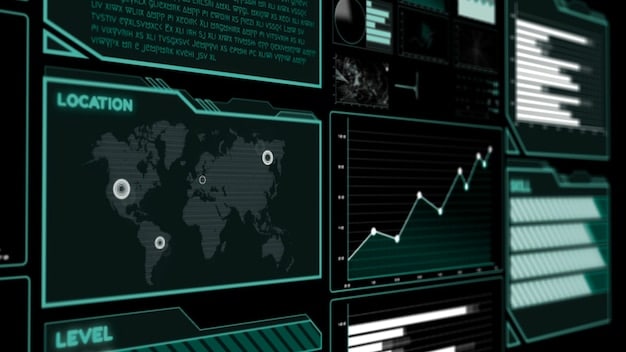AI-Powered Cybersecurity: Protecting Your Data in 2025

AI-powered cybersecurity in 2025 will leverage advanced machine learning to proactively identify and neutralize threats, providing enhanced protection against sophisticated cyberattacks and ensuring data security for individuals and organizations.
As we approach 2025, the landscape of cybersecurity is rapidly evolving, with artificial intelligence (AI) playing an increasingly critical role. AI-powered cybersecurity: How to protect your data in 2025 is no longer a futuristic concept but a present-day necessity, and learning how to adjust to the ever-changing environment that AI creates is quintessential to long term security.
The Rising Tide of Cyber Threats
The threat landscape is constantly changing, with cybercriminals becoming more sophisticated in their methods. As we approach 2025, understanding the nature and scale of these threats is crucial for effective cybersecurity.
Evolving Attack Vectors
Cyberattacks are no longer limited to simple viruses and phishing scams. Modern threats include ransomware, supply chain attacks, and sophisticated social engineering tactics.
The Cost of Cybercrime
The financial impact of cybercrime is staggering, costing businesses billions of dollars annually. Beyond financial losses, data breaches also damage reputation and erode customer trust.
- Ransomware attacks are increasing in frequency and severity.
- Data breaches expose sensitive information, leading to identity theft and financial loss.
- Supply chain attacks compromise entire networks through vulnerable third-party vendors.
Staying ahead of these threats requires a proactive approach that leverages advanced technologies like AI. Businesses must invest in robust cybersecurity measures, including AI-powered solutions, to protect their digital assets and maintain customer trust.

AI: A Game Changer in Cybersecurity
AI is revolutionizing cybersecurity by automating threat detection, enhancing incident response, and providing proactive protection. Its ability to analyze vast amounts of data in real-time makes it an indispensable tool in the fight against cybercrime.
Machine Learning for Threat Detection
Machine learning algorithms can identify patterns and anomalies that indicate malicious activity, enabling faster and more accurate threat detection.
Automated Incident Response
AI can automate incident response tasks, such as isolating infected systems and blocking malicious traffic, reducing the time it takes to contain and remediate cyberattacks.
- AI enhances threat detection by identifying zero-day exploits.
- Automated response minimizes damage from successful attacks.
- Predictive analysis anticipates future threats based on historical data.
AI’s ability to learn and adapt makes it a formidable tool in cybersecurity, providing organizations with a significant advantage in defending against cyber threats. The constant evolution of AI algorithms ensures that security measures remain effective against emerging attack vectors.
Key AI-Powered Cybersecurity Solutions
AI is integrated into a variety of cybersecurity solutions, each designed to address specific threats and vulnerabilities. Understanding these solutions is essential for building a comprehensive security posture.
Behavioral Analytics
Behavioral analytics uses AI to monitor user and system behavior, identifying anomalies that could indicate insider threats or compromised accounts.
AI-Driven Antivirus
Traditional antivirus software relies on signature-based detection, which is ineffective against new and unknown threats. AI-driven antivirus uses machine learning to identify malware based on its behavior, providing superior protection against zero-day exploits.
AI-powered cybersecurity solutions offer a range of benefits, including:
- Enhanced threat detection capabilities.
- Automated response to security incidents.
- Proactive identification of vulnerabilities.

Implementing AI Cybersecurity in Your Organization
Implementing AI cybersecurity requires careful planning and execution. Organizations must assess their specific needs and choose solutions that align with their security goals.
Assessing Your Cybersecurity Needs
Before implementing AI cybersecurity, organizations should conduct a thorough risk assessment to identify vulnerabilities and prioritize security investments.
Choosing the Right AI Solutions
Selecting the right AI solutions requires careful evaluation of available products and vendors. Consider factors such as accuracy, scalability, and integration with existing security infrastructure.
- Start with a pilot project to test AI solutions in a controlled environment.
- Integrate AI cybersecurity with existing security tools for enhanced protection.
- Provide ongoing training to security personnel on how to use and manage AI solutions.
Successfully implementing AI cybersecurity requires a strategic approach that encompasses assessment, selection, and integration. By carefully planning and executing these steps, organizations can maximize the benefits of AI and strengthen their overall security posture.
Challenges and Limitations of AI Cybersecurity
While AI offers significant advantages in cybersecurity, it also presents certain challenges and limitations. Understanding these issues is crucial for effective deployment and management.
The Need for High-Quality Data
AI algorithms rely on high-quality data to learn and make accurate predictions. Insufficient or biased data can lead to inaccurate threat detection and false positives.
The Human Element
AI cybersecurity is not a replacement for human expertise. Security professionals are still needed to interpret AI-generated insights and make informed decisions.
- AI algorithms require continuous monitoring and refinement to maintain their accuracy.
- AI can be vulnerable to adversarial attacks designed to fool algorithms.
- Ethical considerations must guide the development and deployment of AI cybersecurity solutions.
Addressing these challenges requires a holistic approach that combines AI with human expertise, ensuring that security measures are both effective and ethical. Continuous monitoring, refinement, and ethical considerations are essential for maximizing the benefits of AI in cybersecurity.
The Future of AI in Cybersecurity
The future of AI in cybersecurity holds tremendous promise, with ongoing advancements in machine learning, natural language processing, and other AI technologies. These innovations will further enhance threat detection, incident response, and proactive protection.
Emerging AI Technologies
New AI technologies, such as generative adversarial networks (GANs), are being developed to create more sophisticated and realistic simulations of cyberattacks, allowing security teams to better prepare for and respond to emerging threats.
The Convergence of AI and Automation
The convergence of AI and automation will enable fully automated security operations, where AI algorithms autonomously detect, respond to, and remediate cyberattacks without human intervention.
- AI will enable more proactive and adaptive security measures.
- AI will play a critical role in securing emerging technologies, such as IoT and cloud computing.
- Collaboration between AI and human experts will drive innovation in cybersecurity.
The future of AI in cybersecurity is bright, with ongoing advancements promising to transform the way organizations protect their digital assets. By embracing these innovations and fostering collaboration between AI and human experts, we can create a more secure and resilient cyber ecosystem.
| Key Point | Brief Description |
|---|---|
| 🛡️ AI Threat Detection | Uses ML to spot unusual patterns instantly. |
| 🤖 Automated Response | AI handles attacks quickly, reducing human delays. |
| 🔍 Behavioral Analysis | Tracks user activity to find internal threats. |
| 🌐 Future Trends | Merging AI with automation enables advanced security. |
Frequently Asked Questions
▼
AI algorithms analyze large datasets to identify patterns indicative of cyber threats. This enables faster and more accurate detection compared to traditional methods, especially for zero-day exploits and evolving attack vectors.
▼
AI’s effectiveness relies on high-quality data; biased or insufficient data can lead to inaccuracies. Additionally, AI is not a replacement for human expertise, and it can be vulnerable to adversarial attacks designed to fool algorithms.
▼
Effective implementation involves a thorough risk assessment, strategic selection of AI solutions, and seamless integration with existing security infrastructure. Ongoing training for security personnel is also crucial for managing and interpreting AI insights.
▼
Behavioral analytics employs AI to monitor user and system behavior, identifying anomalies that could indicate insider threats or compromised accounts. This helps organizations detect and respond to potential security breaches proactively.
▼
Future trends include the convergence of AI and automation, enabling fully automated security operations. Emerging AI technologies like generative adversarial networks (GANs) will also enhance threat simulation and preparedness for emerging cyber threats.
Conclusion
In conclusion, AI-powered cybersecurity is a critical component of protecting data in 2025, offering advanced threat detection, automated response, and proactive protection. While challenges exist, the benefits of implementing AI in cybersecurity far outweigh the limitations, paving the way for a more secure and resilient cyber ecosystem.





